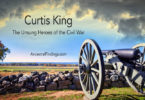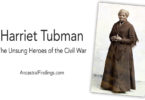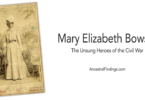Clara Barton was a humanitarian, and best known as the founder and first President of the American Red Cross. However, she did so much more than this in her life, including being an unsung Civil War heroine. This is her story.
Clara was born Clarissa Harlowe Barton on December 25, 1821, in North Oxford, Massachusetts, and was called by her nickname of Clara her whole life, starting at a very young age. Her father was Stephen Barton, a militiaman, selectman, and a leader of progressive thought in the Oxford area. Her mother was Sarah Stone, a homemaker.
Clara was painfully shy as a child and was known to only have one close childhood friend because of this. However, she excelled in academics and was sent to school with her older brother Stephen when she was only three years old. Even at that young age, she made herself a standout student in reading and spelling.
She also showed an interest in nursing, beginning when she was ten years old when her brother David fell off the roof of a barn and was severely injured. Clara dedicated herself to making him well, giving him medication and treating him with leeches (which was common for the time), long after doctors had given up on him. With Clara’s care, David made a full recovery.
Clara was always looking for ways to help around the house, even doing such traditionally masculine things as painting and repairing things. She also rode horses and played roughhouse games with her brothers and male cousins. It was only after she got injured playing with the boys that her mother decided Clara needed to learn some feminine skills, as well. To this end, a female cousin was brought in to teach Clara about social skills and other things women of the time were supposed to know.
To help her overcome her still almost crippling shyness, her parents encouraged her to become a teacher. Clara obtained her first teaching certificate when she was seventeen years old, and ended up teaching for twelve years in schools in Massachusetts, Georgia, and even Canada. She did well in the job, as she knew how to relate to the students on their level. When she participated in a successful campaign to redistrict the schools so poorer children could receive an education, Clara gained the confidence she had long needed. She used this confidence to demand equal pay to the male teachers in her district.
After her mother died in 1851, Clara furthered her education at the Clinton Liberal Institute in New York, where she studied writing and languages. Eventually, she opened her own school in New Jersey, after learning the state didn’t have many public schools. She made her school free, and it was so successful, the local school board took it over and replaced her as principal by a man. She ended up having a nervous breakdown over it, and quit the school she founded.
Clara moved to Washington, D.C., where she was the first female clerk in the federal government, working in the Patent Office. However, she found, once again, that the USA was not ready for females in positions of power or influence, and after much political opposition, her position was reduced to a copyist. Later, US President James Buchanan fired her for her abolitionist views. Still, she returned to the patent office in 1861 as a temporary copyist, hoping to make way for more women to work in the federal government.
It was shortly after returning to government work that the Civil War began, and soldiers from Massachusetts who were injured in the Baltimore Riot were transferred to the nation’s capital for care. Clara signed on to help nurse them, and provided personal care on a level few other nurses would give. Because these soldiers were from Massachusetts, Clara knew many of them from growing up there, and some had even been her students. She provided them with medical care, food, clothing, and supplies, along with a few other women who were helping her. In addition to learning new nursing skills, Clara also learned how to provide emotional support to the soldiers, reading to them, and writing letters to their families for them, as well as just talking to them and letting them talk to her.
Clara brought provisions directly onto battlefields and used her own home as a storeroom for the things the soldiers needed. By 1862, she gained permission from the US Quartermaster to work on the front lines, putting herself in danger to bring soldiers the supplies they needed (medical, clothing, food, and anything else they might require while in the field). There were people in high places who noticed her work, and they became her patrons, including Senator Henry Wilson of Massachusetts.
During the war, Clara worked to distribute supplies, to clean field hospitals, and to nurse and feed wounded soldiers in the vicinity of some of the most infamous battles of the Civil War, such as both Battles of Bull Run, Antietam, and Fredericksburg. And, Clara did not discriminate in her ministrations. She helped tend to both Union and Confederate soldiers.
She was given charge of the hospitals at the front of the Army of the James in 1864, and became known as the “American Florence Nightingale” and the “Angel of the Battlefield.” She was so close to the action, that once, a bullet went through the dress of her sleeve, leaving her uninjured, but killing the man standing beside her, who she was tending.
Clara’s work on behalf of Civil War soldiers on both sides of the war did not end when the war did, either. After the war, she learned that there were thousands of unanswered letters at the War Department from relatives of soldiers who were looking for any information on what happened to them. The War Department did not answer these letters, because most of the soldiers in question were buried on battlefields and/or unmarked graves. Clara personally applied to President Lincoln for permission to answer these letters and was given it, and her “Search for the Missing Men” project began.
This project turned into the Office of Missing Soldiers in Washington, D.C., and its purpose was to find or identify Civil War soldiers who were killed or missing in action. She had her own building for this project, and she and her assistants wrote more than forty-one thousand letters and located more than twenty-two thousand missing soldiers. She personally helped identify and bury more than thirteen thousand soldiers from the Andersonville prison camp in Georgia and found and buried (with proper markers) more than twenty thousand more soldiers over the next four years. Congress even gave her $15,000 to use toward the project.
After this, she continued her humanitarian and social activism work, becoming a suffragette, working toward civil rights for emancipated slaves, and touring the country talking about her Civil War experience. She was introduced to the Red Cross in 1869 in Switzerland, where she was spending time on doctor’s orders for her health, and eventually opened the American branch, known as the American Red Cross, and became its first president.
Clara did much work with the Red Cross both in America and abroad over the next few decades which is what she is best known for these days. However, her heroism in the Civil War should not be forgotten, as she made a positive difference in the lives of tens of thousands of soldiers and their families. Clara truly was a Civil War heroine.






